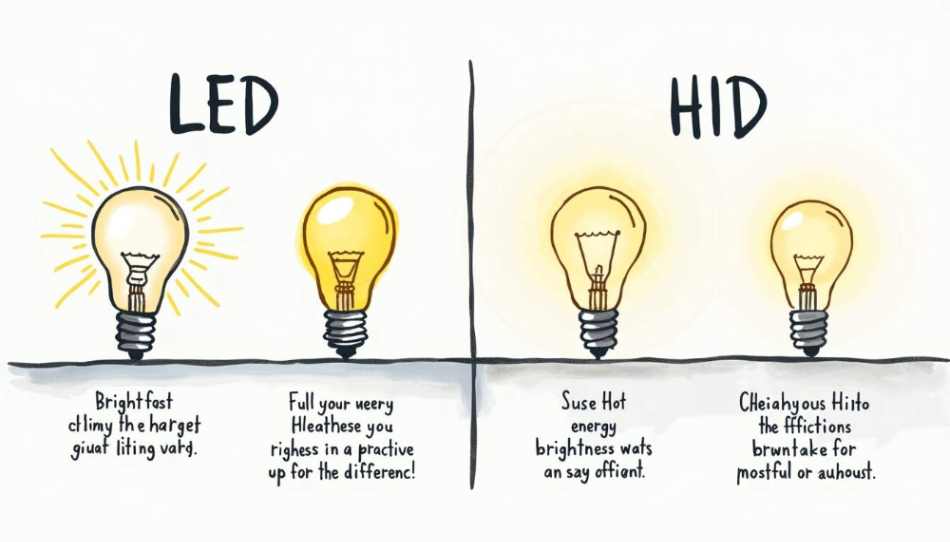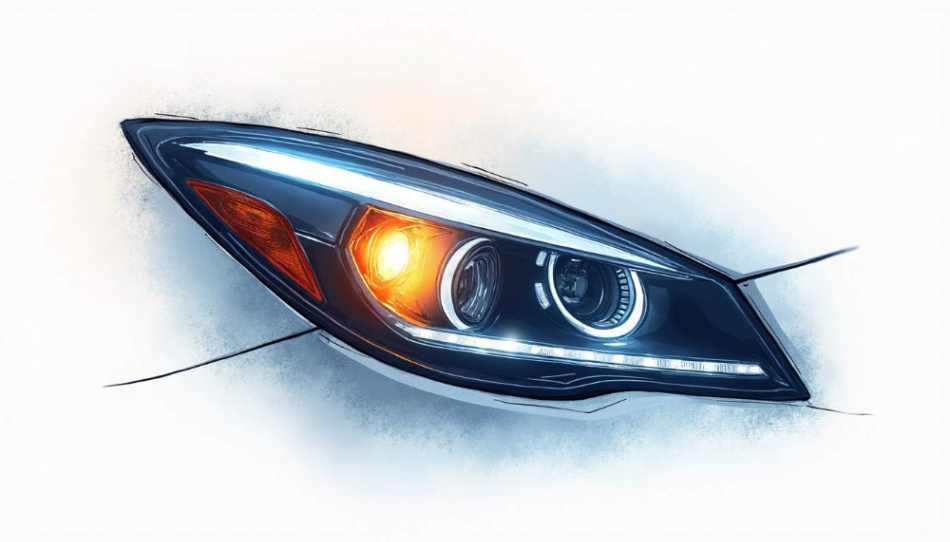As automotive technology continues to advance, lighting systems are undergoing a significant transformation. Among the various options available, LED (Light Emitting Diode) headlights are increasingly becoming the preferred choice for many vehicle owners. In contrast, HID (High-Intensity Discharge) lights have long held their ground. This article explores the advantages of LED headlights over HID lights, focusing on their functionality, technical differences, practical benefits, and limitations of HID technologies.
Understanding LED and HID Lights
To grasp why LED headlights are often seen as superior, it is essential to understand what LED and HID lights are. Each technology has distinct characteristics, affecting performance, efficiency, and overall user experience.
What are LED Headlights?
LED headlights are a type of automotive lighting that utilizes semiconductor technology to convert electrical energy directly into light. Unlike traditional incandescent bulbs, which use a filament, or HID lights that rely on gas, LEDs offer a unique combination of energy efficiency and luminosity. They are compact, durable, and can be produced in a variety of colors, making them versatile for automotive lighting applications.
One of the standout features of LED headlights is their ability to provide instant illumination. As soon as the vehicle is powered, LEDs light up, ensuring that drivers have immediate visibility. This quick response time is particularly beneficial in situations where immediate lighting is necessary, such as navigating dark roads or avoiding obstacles. Furthermore, the longevity of LED lights is remarkable; they can last up to 25,000 hours or more, significantly reducing the frequency of replacements and maintenance costs for vehicle owners.
Another advantage of LED technology is its energy efficiency. LED headlights consume significantly less power compared to their HID counterparts, which translates to less strain on the vehicle's electrical system and improved fuel efficiency. Additionally, the cooler operating temperature of LEDs means that they produce less heat, which can be advantageous in preserving the integrity of surrounding components and enhancing overall vehicle safety.
What are HID Lights?
HID lights, on the other hand, are a type of gas-discharge lighting. They work by passing an electrical current through a gas-filled bulb, creating an electric arc between two electrodes. The result is a powerful beam of light that is significantly brighter than traditional halogen bulbs. HID lights are often favored for their intensity and the ability to produce a larger light output, making them popular for higher-end vehicles.
However, HID headlights require a warm-up period to reach their full brightness, which can delay effective illumination in critical situations. This warm-up time can be a disadvantage for drivers needing immediate visibility in emergency or low-light conditions. Moreover, HID lights can also produce a bluer light, which some drivers find aesthetically pleasing, but it can lead to increased glare for oncoming traffic, raising concerns about road safety.
Another consideration with HID technology is the complexity of installation. Unlike LED systems that can often be retrofitted with ease, HID lights may require specific ballasts and wiring to function correctly, which can complicate upgrades or replacements. Despite these challenges, many enthusiasts appreciate the unique qualities of HID lights, particularly for their ability to illuminate a wider area, making them a popular choice for off-road vehicles and those who frequently drive in rural settings.
The Technical Differences Between LED and HID Lights
While both LED and HID headlights have their merits, several technical differences place them in different categories regarding performance, efficiency, and longevity.
The Light Output
LED headlights provide a focused and direct beam. This precision means that the light is distributed effectively on the road ahead without much scattering. In contrast, HID lights tend to produce a broader beam, which can sometimes result in glare for oncoming traffic. The focused light of LEDs improves visibility for the driver, enhancing safety during nighttime driving or adverse weather conditions.
Furthermore, the color temperature of LED lights can be customized to produce various shades of light, fostering greater visibility and comfort. Most LED headlights emit a whiter light that closely resembles daylight, which can significantly improve road visibility compared to the bluish hue of many HID systems. This daylight-like illumination not only helps in spotting road signs and obstacles but also reduces eye strain during long drives, making for a more pleasant driving experience.
Moreover, the directional nature of LED technology allows for innovative designs in headlight assemblies. Manufacturers can create intricate light patterns that enhance the aesthetic appeal of vehicles while also improving functionality. For example, adaptive LED headlights can adjust their beam pattern based on the vehicle's speed and steering angle, providing optimal illumination in curves and turns. This adaptability is something that traditional HID systems struggle to achieve, further solidifying LEDs as the superior choice in modern automotive lighting.
The Energy Efficiency
When it comes to energy consumption, LEDs lead the pack. LED headlights consume significantly less power than their HID counterparts. This efficiency is crucial not only for the environment but also for the car's overall energy management. A lower power draw translates into reduced strain on the vehicle's electrical system, potentially leading to longer battery life.
HID lights require a ballast to operate, which adds complexity to their installation and increases overall energy consumption. In contrast, LED systems can often be integrated into existing setups with minimal modifications. This ease of integration not only simplifies the installation process but also makes retrofitting older vehicles with modern lighting technology more accessible for consumers.
The Lifespan
Another major advantage of LED headlights is their impressive lifespan. LED lights can last up to 25,000 hours or more, making them a long-lasting option. In contrast, HID lights typically have a lifespan of around 2,000 to 3,000 hours. The longevity of LED systems means fewer replacements, translating into cost savings and less waste over time.
Furthermore, LEDs do not burn out suddenly. Instead, they gradually diminish in brightness, providing drivers with advanced notice that a replacement is needed. This characteristic adds to the overall safety and reliability of LED technology.
The Practical Benefits of LED Headlights
Beyond the technical aspects, LED headlights offer numerous practical benefits that enhance the driving experience and contribute to overall vehicle safety.
Improved Visibility
The primary purpose of headlights is to illuminate the road. LED headlights excel in this regard by providing a bright and extensive lighting range. This enhanced visibility is crucial for preventing accidents, allowing drivers to spot pedestrians, obstacles, and road signs at greater distances.
Lower Maintenance Costs
As mentioned earlier, the long lifespan of LED headlights equates to lower maintenance costs. Car owners face fewer disruptions related to headlight failure. Additionally, because LEDs are more energy-efficient, there is less wear and tear on the vehicle’s electrical system, thus reducing overall maintenance needs.
Environmental Impact
LED headlights are also better for the environment. Their energy efficiency leads to lower CO₂ emissions when compared to traditional lighting systems. This sustainability aspect appeals to eco-conscious consumers and aligns with broader trends toward environmentally friendly transportation solutions.
The Limitations of HID Lights
While HID lights have been a popular choice for many automobile manufacturers, they come with several limitations that may deter some consumers.
Glare Issues
One of the significant drawbacks of HID lights is their potential to cause glare for other drivers. The intense brightness of HID headlights can be blinding, especially when the lights are incorrectly aimed.
Replacement Costs
Replacing HID bulbs can also be costlier compared to LED. The need for specialized ballasts and the labor involved in replacing these components can add up quickly.
Energy Consumption
Despite their high light output, HID systems tend to consume more energy, which can impact fuel efficiency.
Conclusion
As technology continues to evolve, LED headlights offer a multitude of advantages over HID lights, including improved visibility, energy efficiency, longevity, and less environmental impact. With their growing popularity, it seems likely that LED technology will continue to illuminate the road ahead.













